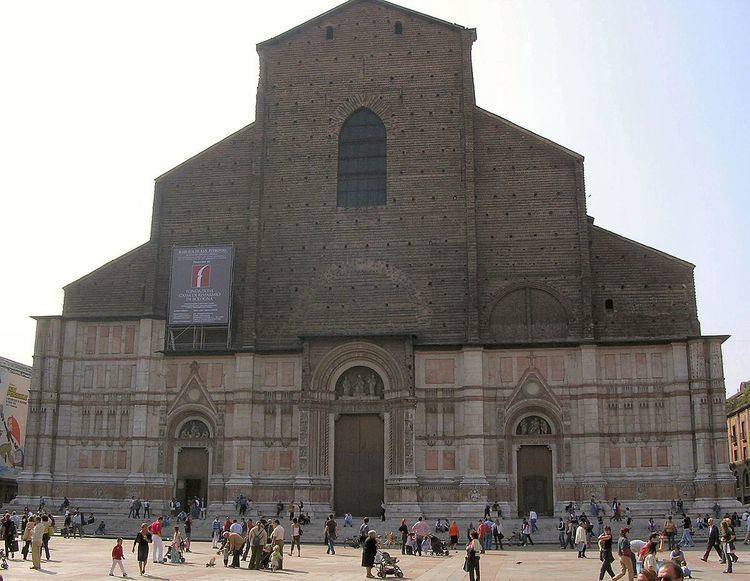Province Province of Bologna Architect Antonio di Vincenzo | Phone +39 051 231415 | |
 | ||
Address Piazza Galvani, 5, 40124 Bologna, Italy Architectural style Italian Gothic architecture Similar Piazza Maggiore, Towers of Bologna, Fountain of Neptune - Bologna, Archiginnasio of Bologna, Sanctuary of the Madonna Profiles | ||
San petronio basilica bologna emilia romagna italy europe
The Basilica of San Petronio is the main church of Bologna, Emilia Romagna, northern Italy. It dominates Piazza Maggiore. It is the tenth-largest church in the world by volume, 132 metres long and 66 metres wide, while the vault reaches 45 metres inside and 51 metres in the facade. With its volume of 258,000 m³, it is the largest (Gothic or otherwise) church built in bricks of the world.
Contents
- San petronio basilica bologna emilia romagna italy europe
- Bologna san petronio basilica italy a day in life
- Architecture
- Interior
- Music
- Cassinis Meridian Line
- Middle Ages
- Modern terrorist attacks
- References
The basilica is dedicated to the patron saint of the city, Saint Petronius, who was the bishop of Bologna in the fifth century. The construction was a communal project of Bologna, not of the bishops: the property was a symbol of communal power that was not transferred from the city to the diocese until 1929; the basilica was finally consecrated in 1954. It has been the seat of the relics of Bologna's patron saint only since 2000; until then they were preserved in the Santo Stefano church of Bologna.
Bologna san petronio basilica italy a day in life
Architecture
Following a council decree of 1388, the first stone of construction was laid June 7, 1390, when the town council entrusted Antonio di Vincenzo with raising a Gothic cathedral. In order to make room for this monumental construction, the adjacent Curia of Sancti Ambrosii was demolished, together with the majority of one of the city’s burgs, including at least eight churches and towers. Works lasted for several centuries: after the completion of the first version of the facade, in 1393 the first pair of side chapels were begun. The series were completed only in 1479.
However, in 1514 Arduino degli Arriguzzi proposed a revised plan in the form of a Latin cross with the intent to outdo even Saint Peter's Basilica of Rome, the greatest church of the Western Christian world even in its ancient version. According to tradition, Pope Pius IV halted such a majestic project.
The facing of the main facade remains unfinished: many architects (notably Baldassarre Peruzzi, Vignola, Andrea Palladio and Alberto Alberti) were commissioned to propose solutions for it, but a definitive one was never found. Jacopo della Quercia of Siena enriched the main doorway with sculptures (illustrated, left) and two new small flanking doorways, with subjects taken from the Old Testament, forming a traditional prelude to the new dispensation that is represented by the basilica itself. The heroic nudes of Adam and other figures in the rectangular bas-relief panels were an inspiration to artists of the Renaissance. The 65-metre-tall (213 ft) campanile was built at the end of the 1400s.
Interior
The interior houses a Madonna with Saints by Lorenzo Costa the Younger and a Pietà by Amico Aspertini. Also the colours of the walls and the stained glass windows are noteworthy. The choir was made in the 15th century by Agostino de' Marchi, while the ciborium is a work by Vignola.
Jacopo Barozzi da Vignola was chief architect of the fabbrica; his is the design of the ciborium over the altar. The vaulting and decoration of the central nave is by Girolamo Rainaldi, who completed them in 1646-1658. The twenty-two chapels are the following:
Music
Bologna was a principal centre of Baroque music in Italy. The musical organisation had been officially instituted by Pope Eugenius IV in 1436; the first regularly paid instrumentalists were added in the late sixteenth century, and in the seventeenth century San Petronio was renowned for its sacred instrumental and choral music, with its two great organs, completed in 1476 and 1596, both still in remarkably original condition; the library remains a rich archival repository. Three successive maestri di cappella marked the great age of music at San Petronio: Maurizio Cazzati (1657–71), Giovanni Paolo Colonna (1674–95) and Giacomo Antonio Perti (1696–1756). The current maestro, since 1996, is the harpsichordist Sergio Vartolo who has revitalised the cappella with a series of recordings for Naxos, Tactus, Brilliant Classics and Bongiovanni.
Cassini's Meridian Line
The church hosts also a marking in the form of a meridian line inlaid in the paving of the left aisle in 1655; it was calculated and designed by the famous astronomer Giovanni Domenico Cassini, who was teaching astronomy at the University. A meridian line does not indicate the time, but instead the day of the year and also meridian lines were used to accurately determine the length of the solar year. At 66.8 metres (219 ft) it is one of the largest astronomical instruments in the world, allowing measurements that were for the time uniquely precise; Cassini and Domenico Guglielmini published an illustrated account of how the meridian was accomplished in 1695.
Middle Ages
Pope Clement VII chose it for the coronation of Charles V in 1530. Elisa Bonaparte, Napoleon Bonaparte's sister, is buried here.
Modern terrorist attacks
In 2002, five men who it was believed were connected to Al Qaeda and were planning to blow up the building, were arrested. Again in 2006, plans by Muslim terrorists to destroy the Basilica were thwarted by Italian police. The terrorists claimed that a 15th-century fresco inside was insulting to Islam. The fresco, painted by Giovanni da Modena, depicts Muhammad in Hell being devoured by demons.
